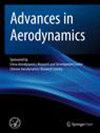Effect of tip clearance on non-synchronous propagating flow disturbances of compressor rotors under high aerodynamic loading conditions
IF 2.3
3区 工程技术
Q2 ENGINEERING, MECHANICAL
引用次数: 0
Abstract
The complex tip flow instability and its induced non-synchronous vibration have become significant challenges, especially as aerodynamic loading continues to increase. This study investigates the effects of tip clearance on non-synchronous propagating flow disturbances of compressor rotors under high aerodynamic loading conditions by conducting full-annulus unsteady numerical simulations with three typical tip clearance values for a 1-1/2 stage transonic compressor. The non-synchronous aerodynamic excitation frequency, circumferential mode characteristics, and annular unstable flow structures are analyzed under near stall conditions. The results show that the total pressure ratio and normalized mass flow parameters first increase and then decrease as the tip clearance increases from 0.5%C (where C represents the tip chord length) to 2%C under high aerodynamic loading conditions, instead of constantly decreasing. For the 0.5%C tip clearance case, the traveling large-scale tornado-like separation vortices cause a low non-synchronous aerodynamic excitation frequency and severe pressure fluctuations. The periodic shedding and reattachment processes of the rotor blades separated by 2 – 3 pitches result in 19 dominant mode orders in the circumferential direction. As the tip clearance increases from 1%C to 2%C, the difference of tip flow structures in each blade passage is significantly weakened, and the dominant mode order of the disturbance is equal to the rotor blade-passing number. The pressure fluctuation is mainly caused by cross-channel tip leakage flow, and the aerodynamic excitation frequency exhibits evident broadband hump characteristics, which has been reported as a rotating instability phenomenon.在高空气动力负荷条件下,叶尖间隙对压缩机转子非同步传播流动扰动的影响
复杂的尖端流动不稳定性及其诱发的非同步振动已成为重大挑战,尤其是随着空气动力载荷的不断增加。本研究通过对 1-1/2 级跨音速压缩机进行全模量非稳态数值模拟,采用三种典型的顶端间隙值,研究了在高空气动力载荷条件下,顶端间隙对压缩机转子非同步传播流动扰动的影响。分析了近失速条件下的非同步空气动力激励频率、圆周模态特性和环形不稳定流动结构。结果表明,在高空气动力载荷条件下,随着顶端间隙从 0.5%C(C 代表顶端弦长)增加到 2%C,总压比和归一化质量流量参数不是持续下降,而是先增加后下降。在翼尖间隙为 0.5%C 的情况下,移动的大尺度龙卷风状分离涡导致较低的非同步气动激励频率和严重的压力波动。相隔 2 - 3 个螺距的转子叶片的周期性脱落和重新附着过程导致圆周方向上出现 19 个主导模态阶次。随着叶尖间隙从 1%C 增加到 2%C,每个叶片通道中的叶尖流动结构差异明显减弱,扰动的主模阶等于转子叶片通过数。压力波动主要由跨通道叶尖泄漏流引起,气动激励频率表现出明显的宽带驼峰特征,有报道称这是一种旋转不稳定现象。
本文章由计算机程序翻译,如有差异,请以英文原文为准。
求助全文
约1分钟内获得全文
求助全文

 求助内容:
求助内容: 应助结果提醒方式:
应助结果提醒方式:


